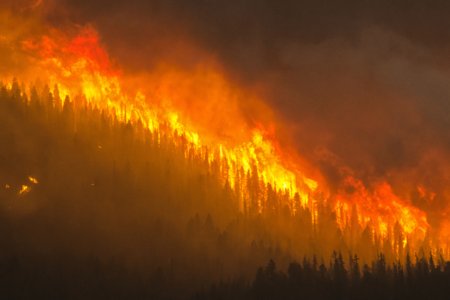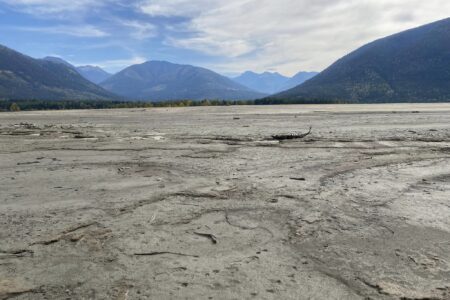Why we need to stop trying to 'save the planet' and just realize our place in it
By Peter Baker, Ecologist
In an extract from his new book the Jolly Pilgrim, Peter Baker argues that a Gaian consciousness is slowly emerging out of our efforts to overcome climate change and other environmental challenges.
The human race has a problem in its relationship with the environment. That problem is an intrinsic consequence of running a technological civilization on the surface of a planet and it’s one we were destined to face since long before perceiving it.
Now that we do perceive it, and everybody’s talking about it, we should start being more realistic about the historical context of those discussions.
All life forms exploit their surroundings to get what they need to survive. Daisies need sunlight, squirrels need acorns, whales need krill. We humans, however, have always been rather more ambitious about what constitutes our needs and, for 100,000 years, those ambitions and their side effects have been inexorably increasing.
By the time anatomically modern humans were spreading across the globe after 60,000 BCE, already no other animal could stand against us. We’d become the invincible global super-predator. Snuffing out species. Re-ordering food chains. Distorting ecosystems.
Agriculture increased our impact on the world to a new scale. Watercourses were redirected, forests cleared and marshes drained. Systematic land alteration on a massive scale. The face of the world artificially reworked.
The Industrial Revolution intensified our influence once more as we twisted minerals into artefacts, scorched fossils into electricity, shaped rock and clay into cloud-skimming edifices and began constructing the physical trappings of this grand civilization of ours.
The stage for this drama has been the surface of planet Earth, the climatic and biological systems of which are fantastically complex, poorly understood and intertwined through an assortment of mysterious and subtle feedback mechanisms. Everywhere those systems are being modified by the newfangled civilization sitting among them, and every day that civilization grows larger and more elaborate.
To set our environmental situation in fundamental terms: this universe, and in particular this planet, is set up in such a way that once a species of hyper-intelligent tool-using omnivores (with apparently bottomless ingenuity and imagination) gets going their activities are bound, sooner or later, to reach such a magnitude that they freak out the constitution of the planet on which they live.
Life on earth
We didn’t choose to be here. The long chain of technological innovations that brought us to this point was not premeditated. No one sat down and planned the invention of agriculture or the Industrial Revolution.
However, now we’re here there can be no turning back. We don’t have the option of returning to our pre-agricultural days of hunting, gathering and living off nature’s rhythms. Population densities far exceed levels that can be nourished through such practices.
Hunter-gatherer peoples live at average population densities of less than one person per square kilometre. Population densities in the heavily populated regions of the world are now well over 100 people per square kilometre (and reach 800 people per square kilometre in places like the Ganges plain).
With this is mind, some have sometimes suggested the Earth has more humans than she can sustain and that a population crash is both inevitable and necessary. As one with an optimistic view of the problem-solving panache of humankind, I think we can come up with a more creative way forward than that.
In essence we’ve naively constructed a civilization that is not environmentally sustainable. Now we have to re-craft it into one that is. It’s an enormous job, but in the early twenty-first century of my journey it was well under way.
Off the Australian east coast, whales that had recently been hunted towards oblivion were being fawned over from tourist boats.
In the Amazon, ecotourism was turning conservation into tourist dollars. Businessmen, politicians and environmentalists were wrestling to define rules for resource extraction while, in Quito, consultants struggled to interpret them.
North American students were studying the chemistry of ecosystems. Venture capitalists were investing tens of billions of dollars to pin down the science of renewable power and the business models to exploit it.
In 20 years global warming had gone from an obscure environmentalist concern to a signature issue of international politics, and, across the world, a debate about energy was beginning to rage.
A technological civilization is not anathema to environmental sustainability, even if it has a growing economy. It’s true that the character of our civilization’s hardware and logistics over the past few centuries has meant that the size of economies has been proportional to their environmental side effects, but it won’t always be that way.
The nature of tomorrow’s economy will be radically different from today’s and, ultimately, its size is a subjective thing. Economic growth doesn’t have to mean ever-bigger factories. A firm of lawyers generates more economic output (and a lot more hot air) than a polluting mill, even though it has lower carbon emissions.
There’ll always be physical parameters constraining some things, such as the amount of fresh water and certain elements available, but using such resources elegantly and effectively has only just commenced.
The logistics of civilization can, in the future, become efficient in ways so far undreamed of. One day we may establish companies that use geothermal energy to make recycling machines from recycled materials and have very low carbon emissions indeed.
Changing civilization so that it works in harmony with the environment isn’t impossible, it’s just a very big problem.
Why we need environmental science
Right now everyone’s talking about climate change. It’s come to light that dumping large volumes of heat-trapping gases into the atmosphere for 200 years may have affected the atmosphere. This fact is causing a lot of angst.
First of all, let’s not forget just how extraordinarily inconvenient this is. Carbon dioxide (CO2) is the basic waste product of nearly all our energy and transportation systems. At this point in history, expanding the capacity of those systems will dramatically improve the life quality of billions of humans.
In addition, reducing carbon emissions requires a planet full of self-absorbed Homo sapiens to act in a coordinated way that is against their immediate best interests.
Given all that, achieving such reductions was always going to be extremely difficult and involve long, protracted and acrimonious global arguments about what to do (precisely like the arguments now raging).
Ultimately, what are the possibilities?
Around 18,000 years ago, what is now London stood at the foot of an ice sheet that stretched to the pole. Scotland, directly to the north, lay under two kilometres of the stuff. Sea levels were 100 metres lower than they are today.
Around 74,000 years ago, a supervolcano exploded on the Indonesian island of Sumatra, throwing 3,000 cubic kilometres of rock into the stratosphere, turning south-east Asia into a giant firestorm and blanketing India with a metre of ash.
Around 130,000 years ago, hippopotami found it warm enough to splash about in the river Thames, where glaciers, and one day London, would later stand.
If you go back tens of millions of years you come to the great extinction events: gargantuan meteorites slamming into the planet, consigning it to millennia of ecological pandemonium at a time.
Stuff like that happens. The Earth gets over it.
The worst-case scenarios of climate change go something like this: the Siberian tundra releases its methane stores into the atmosphere, global warming spirals out of control, the Greenland and Antarctic ice sheets melt (a process which takes centuries) and sea levels rise by tens of metres over that period.
If that happens (and it might), it will be extremely unpleasant. Some of the richest, most heavily populated and fertile parts of the world (including most of the really big cities) will be inundated.
Billions of people will be displaced and there will be a prolonged period of global chaos and disruption. But it will not constitute the end of the world, or even the end of civilisation. It will just be really nasty.
So we’re in a race. The magnitude of our civilisation inexorably increases, while we continuously look for ways to mitigate its side effects, so Earth doesn’t squish us. The effort with which we run this race will be a key test of our mettle as a species and heavily influence how much fun the next few centuries are going to be.
But, whatever fate awaits humankind, one million years from now Earth will be a place of forests, lakes and animals. When we talk of destroying (or saving) the planet, we’re taking ourselves too seriously.
Beyond climate change
Human civilization has reached a bottleneck. We’ve now entered a period of history during which our relationship with the environment is unstable. It is a period that will see some level of climate change, ecosystem disruption and species loss. What is unknown is how deep and traumatic this period will be.
CO2-induced climate change may (or may not) turn out to be our environmental Achilles’ heel. But even after it’s eventually brought under control, there will be other mechanisms for environmental catastrophe waiting in the wings that we don’t currently perceive.
We’re nowhere near understanding all the long-term effects of running a technological civilization on the surface of a planet.
Three hundred years ago, who would have guessed that an overarching problem for humanity would soon be to manage the machinery of civilization so as to limit the release of certain gases? We didn’t even know CO2 existed until the eighteenth century.
This learning curve will probably take centuries (at least) to climb. Most of the environmental sciences are at a nascent stage.
Our understanding of them will seem laughably primitive in the lifetimes of people already born. The terms we use to make sense of these problems – terms such as carbon footprint, global warming and sustainable development – are the opening syllables of a conversation that has only just begun.
Even once we’ve re-crafted our civilization to work in harmony with Earth’s ecosphere, we will stand only at the threshold of yet further challenges. For this is a world on which solar cycles, ice ages and mobile coastlines are an implicit part of the gig. CO2-induced climate change is not our great collective environmental challenge – it’s the first in a long line of complicated learning experiences.
Once you’ve killed every great whale in the sea, nothing similar is going to re-evolve any time in the next ten million years. Once an ecosystem completely vanishes, so do the species which rely on it.
Many of the matters over which we humans fret are not, in the grandest scheme of things, a terribly big deal. Others are a very big deal indeed.
Even 1,000 years from now, the hell those foolish twenty-first-century humans put themselves through because sports utility vehicles (SUVs) pushed their ego buttons may just be one more calamity in this epic multi-generational drama of ours.
But every species consigned to oblivion is a facet of the world which cannot be remade, even in the most distant future of humankind, no matter how many times the seas rise and fall. In attempting to attain a sustainable relationship with our host planet, let’s take the long view. There are uncounted generations to damn us for what’s been destroyed.
The Jolly Pilgrim, by Peter Baker is published by HotHive Books priced £10.99. Available from The HotHive and Amazon
























Comments